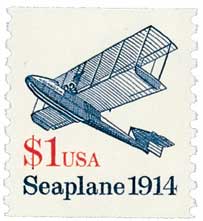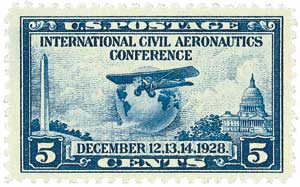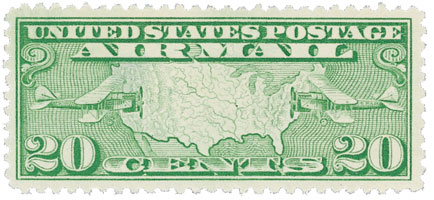
# C9 - 1927 20c Airmail Perf 11
1927 20¢ U.S. Map and Mail Planes
City: Washington, DC
Quantity: 17,616,350
Printed By: Bureau of Engraving and Printing
Printing Method: Flat plate printing
Perforations: 11
Color: Yellow green
Catapult Mail

On July 22, 1929, catapult mail was successfully launched from a German ship to New York. Catapult mail cut down on transatlantic delivery times until advances in aviation enabled planes to make the entire journey even faster.
Up to that time, mail traveling across oceans could only be transported by ship, which could take weeks. Airmail service began in the 1910s, but early planes struggled to safely cross the ocean. Then in the late 1920s, the idea of catapult mail was born. Using this method, mail traveled most of its journey across the ocean on a ship. Once it got within range of its destination, a plane would be launched from its deck, speeding the mail to shore quicker than if the ship completed the journey.

France was the first country to experiment with catapult mail in August 1928. A plane was loaded onto a trolley on a large passenger ship and launched off a ramp using compressed air and powder that sped it to shore at 68 miles per hour. The first such flight occurred on August 13, with the Lioré et Olivier H-198 seaplane launching from the ship 450 miles from coast of New York. The flight took three hours and 12 minutes, about 24 hours less than if the ship had carried it all the way to shore.
Initially pleased with the experiment, French postal officials staged a few more flights. However, not all the flights went so well – some planes were stranded in the water. Additionally, they decided it was too expensive and the catapulting process caused damage to the ships, and the service was discontinued in October 1930.

After France’s initial successful flight, Germany saw the advantages of catapult mail and advanced it even further. They installed a catapult on their new Bremen ocean liner, to launch a brand new Heinkel He12 seaplane. On July 22, 1929, when the ship was 400 miles from the coast, the plane was launched toward New York. It took two-and-a-half hours to reach the coast, and the whole journey took six-and-a-half days. The plane carried 10,997 letters, most of which were stamped with serial numbers. The next day, 3,500 people came out to see the plane and the mayor christened it New York.
German postal authorities considered the catapult mail to be a success – it cut about 20 hours off westward voyages and one to two days off eastward trips. A catapult was also installed on the Europa, which launched the slightly larger Heinkel He58 aircraft. Both planes were eventually replaced by Juncker’s Ju46 planes. Germany continued to use catapult mail for the next few summers. It was unsafe to launch the planes in the bad weather of winter. Then in 1936, the Hindenburg began offering regular transatlantic mail service and catapult mail was discontinued.
1927 20¢ U.S. Map and Mail Planes
City: Washington, DC
Quantity: 17,616,350
Printed By: Bureau of Engraving and Printing
Printing Method: Flat plate printing
Perforations: 11
Color: Yellow green
Catapult Mail

On July 22, 1929, catapult mail was successfully launched from a German ship to New York. Catapult mail cut down on transatlantic delivery times until advances in aviation enabled planes to make the entire journey even faster.
Up to that time, mail traveling across oceans could only be transported by ship, which could take weeks. Airmail service began in the 1910s, but early planes struggled to safely cross the ocean. Then in the late 1920s, the idea of catapult mail was born. Using this method, mail traveled most of its journey across the ocean on a ship. Once it got within range of its destination, a plane would be launched from its deck, speeding the mail to shore quicker than if the ship completed the journey.

France was the first country to experiment with catapult mail in August 1928. A plane was loaded onto a trolley on a large passenger ship and launched off a ramp using compressed air and powder that sped it to shore at 68 miles per hour. The first such flight occurred on August 13, with the Lioré et Olivier H-198 seaplane launching from the ship 450 miles from coast of New York. The flight took three hours and 12 minutes, about 24 hours less than if the ship had carried it all the way to shore.
Initially pleased with the experiment, French postal officials staged a few more flights. However, not all the flights went so well – some planes were stranded in the water. Additionally, they decided it was too expensive and the catapulting process caused damage to the ships, and the service was discontinued in October 1930.

After France’s initial successful flight, Germany saw the advantages of catapult mail and advanced it even further. They installed a catapult on their new Bremen ocean liner, to launch a brand new Heinkel He12 seaplane. On July 22, 1929, when the ship was 400 miles from the coast, the plane was launched toward New York. It took two-and-a-half hours to reach the coast, and the whole journey took six-and-a-half days. The plane carried 10,997 letters, most of which were stamped with serial numbers. The next day, 3,500 people came out to see the plane and the mayor christened it New York.
German postal authorities considered the catapult mail to be a success – it cut about 20 hours off westward voyages and one to two days off eastward trips. A catapult was also installed on the Europa, which launched the slightly larger Heinkel He58 aircraft. Both planes were eventually replaced by Juncker’s Ju46 planes. Germany continued to use catapult mail for the next few summers. It was unsafe to launch the planes in the bad weather of winter. Then in 1936, the Hindenburg began offering regular transatlantic mail service and catapult mail was discontinued.

















